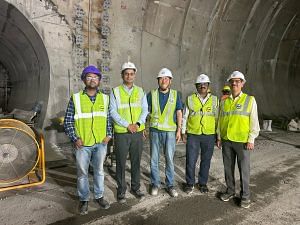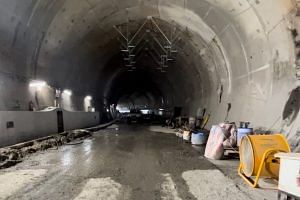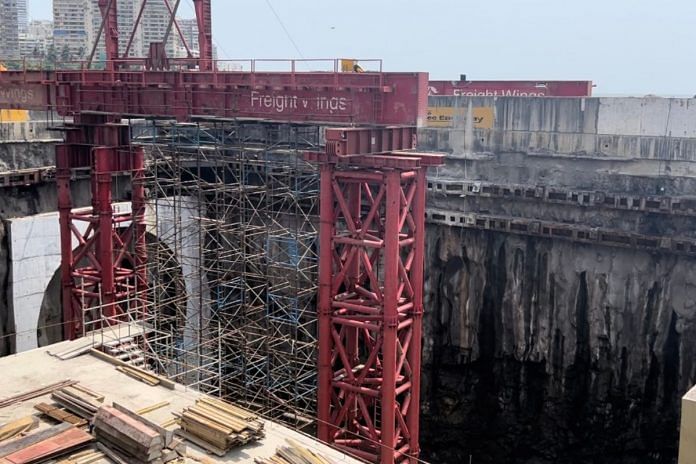Mumbai is about to record a milestone.
Every day for the last two years, ‘Mavala,’ a gigantic machine weighing 2,800 tonnes—the cumulative weight of about 460 male elephants—has been burrowing under the Arabian Sea and Mumbai’s iconic Malabar Hill. It inches forward by about four or five metres daily, shattering the strong basalt rock in its way to smithereens.
In the next seven to nine days, Mavala will have made its way to the other end, wrapping up the challenging task it has been at for the past two years. When it does, Mumbai will have created history for building India’s first undersea twin tunnels—one for traffic from the north to the south and the other for traffic from the south to the north—a key component of Brihanmumbai Municipal Corporation’s flagship coastal road project, which promises to make commute speedier by reducing the travel time between West and South Mumbai.
While the coastal road will be named after Chhatrapati Shivaji’s eldest son, the Maratha warrior king Chhatrapati Sambhaji Maharaj, the tunnel boring machine is named after soldiers from his father’s army; every soldier of Shivaji’s army was called a Mavala. And for the team of 160 people, including 30 engineers, building the 2.07-kilometre twin tunnels through the sea and the hills with heritage buildings just metres away feels nothing short of winning a war.

The first of the twin tunnels had its breakthrough in January 2022, when the boring machine blasted the last few pieces of rock to reveal the light at the other end. A rainbow of coloured firecrackers erupted all around the tunnel as the last of the boulders came crashing down. The team working on the tunnel cheered and clapped almost as loudly as the sound of the celebratory tutari, a traditional horn wind instrument, in the background.

“It was such a joyous moment,” says Sandeep Singh, project manager at Larsen & Toubro, the company contracted with building a part of the coastal road, including the tunnel. Sitting in a conference room at the site office on 10 May, Singh looks around at his colleagues’ faces, urging them to help recount their collective experience.
“I am falling short of words to describe how the first breakthrough felt. The second and the final one will be even more momentous,” he adds.
Also read:
A one-of-its-kind undersea tunnel
The twin tunnels, which will have three lanes on either side, are a crucial part of the city’s 10.5-km showpiece coastal road project.
The tunnel section runs right under Mumbai’s Girgaum Chowpatty and Malabar Hill areas, cutting through a 140-year-old reservoir beneath the famous Hanging Gardens, and Napean Sea Road’s Priyadarshini Park.
Malabar Hill is home to Mumbai’s plushest residential estates, such as Raj Bhavan (which is the Maharashtra governor’s residence), the chief minister’s official residence, several cabinet ministers’ accommodations and the state guest house. However, the residents here have been blissfully unaware of the mammoth machine chipping away at the rock underneath – 14-15 metres below Girgaum Chowpatty, 20 metres under Priyadarshini Park and a good 70 metres below Malabar Hill and the Hanging Gardens.
Engineers say they only received occasional complaints from residents in the last two years, such as when the tunnel boring machine approached a rock cliff close to a building. The ground vibrations would lead to a peculiar sound deep in the night. Like heavy rain pounding the earth.
The Rs 12,721-crore coastal road project, of which the twin tunnels are an integral part, is an access-controlled, signal-free road being built from Marine Drive in South Mumbai to the Worli end of the Bandra-Worli sea link, with a dedicated lane for public transport buses. The road will mostly be built on land reclaimed from the sea.
BMC is reclaiming 111 hectares of land from the sea, of which 70 hectares will be used for recreational purposes and a green zone. It will include a cycle track, a place for jogging, an open auditorium, and a butterfly garden, among other things. The project will also create a new 7.5-km long promenade, more than twice the length of the iconic Marine Drive. Engineers working on the project say that the entire coastal road will likely be opened for public use by early next year. As per a presentation that BMC officials gave ThePrint on 10 May, the Mumbai civic body has completed 74.31 per cent of the total work required on the road.
Project engineers say that the tunnel, however complex, was the only viable way to connect the coastal road.
“Any other structure—like a sea link—would have blocked the Queen’s Necklace [and] Girgaum Chowpatty and disrupted the view. It was very important that we preserved that heritage, the look and feel of this place,” says Chandrakant Kadam, a BMC executive engineer working on the Mumbai coastal road project since 2015.
“A sea link would have also created a security issue at Malabar Hill with VIP addresses such as the Raj Bhavan located there,” he adds.
The twin tunnels will be connected by more mini tunnels, known as cross passages, to allow vehicles and pedestrians to safely cross from one tunnel to the other in case of an emergency.
Also read:
A ‘high-tech’ project
As Vijay Zore’s car descends a reclaimed patch of land behind Priyadarshini Park, smoothly gliding into the first finished tunnel, he continues his commentary on the tunnel’s “high-tech” and “unique” attributes.
The BMC sub-engineer, who has been working on the coastal road project since 2012, when it was in its nascent designing stages, highlights several key features along the way.
He points to the ‘Saccardo’ nozzles, which form an effective ventilation system by injecting an air jet into the tunnel at a high velocity. This technology will also evacuate any smoke from within the tunnel in case of a fire.
On the possibility of a fire gutting the tunnel, Zore explains how the eventuality is rare, considering the entire tunnel is lined by a white fire board, which is sparsely seen in Indian tunnelling. The fire board will help the tunnel withstand abnormally high temperatures and protect the concrete.
Apart from Saccardo nozzles and fire boards, Zore says the tunnel will have a real-time traffic management system that will act like a mini disaster control room, motion and temperature sensor cameras, digital signage, and underground cellular network.
“That’s why I say this is truly a high-tech structure that can be a model for future engineering projects.”
Zore has, perhaps, earned his right to boast. Being associated with the project since it was barely on the drawing board means the engineer has lived through all the hurdles it faced.
Also read: Nashik vineyards recreating Napa Valley experience in India—with ‘bhakri-wine’ tours
Braving through challenges
The first roadblock emerged even before the engineers touched the ground strata.
In April 2020, 70 containers with 184 consignments landed in Mumbai from China, carrying the many parts that would eventually form the ginormous Mavala. As per the plan, experts from China were supposed to arrive in Mumbai to assemble the tunnel boring machine. But travel restrictions induced by the Covid-19 pandemic made it impossible.
“We decided to assemble the machine here by ourselves. We had a few Zoom sessions with the people over there [China]. It took some time, but we assembled the entire tunnel boring machine, part by part, like one would put a TV or laptop together looking at manuals,” says Singh.
The team of engineers from L&T and BMC say it took six months of assembly and one year of driving for Mavala to make its first breakthrough. Its second run for the second tunnel started in March 2022, 78 days after its first breakthrough.
Manik Bhatnagar, L&T’s construction manager (civil), recalls a nail-biting seven-hour period on one of those 78 days. Instead of dismantling the giant machine and transporting it to the other side to begin work on the second tunnel, engineers thought it wise to turn it around on the spot – a feat which, they say, has been attempted only about three or four times in global tunnelling projects so far.
“We rotated the machine 180 degrees. It was an activity that needed a lot of precision but saved the project a lot of time,” Bhatnagar says.
Singh and Bhatnagar also narrate anecdotes of some day-to-day challenges they faced. In 2021, when Mumbai was seeing one of its quintessential heavy downpour days, rainwater entered the tunnel. “We got dewatering pumps to get the water out and had to eagerly wait for the next low tide because that was the only opportunity we had to identify the opening from where rainwater was seeping in and block it,” Bhatnagar says.
On another occasion, at about 3 am, the site ran out of the recycled water that the coastal road project relies heavily on. “We reached out to the Colaba water treatment plant for replenishments,” Bhatnagar says.
But the memory that sticks out the most for the team is from the last few days of July 2022, when they raced against time to break a global tunnel boring record.
L&T broke the previous 455.4-metre record (of distance tunnelled in a month) by driving Mavala for 456.724 metres in a month.
“By 20 July, we were at 250 metres. Now, the entire team was excited, right from the truck driver at the site to the tunnel boring machine operator [and] the supervising managers. We did unbelievably well,” Singh recalls.
The next target for Singh and other team members is the breakthrough of the second tunnel. They hoped to strike daylight a couple of months earlier, but a slight glitch in a part of the tunnel boring machine delayed their plans. Singh, however, says that the team is all set now.
At the Priyadarshini Park end of the tunnel, an enormous red-coloured mega lift structure system is already in place, awaiting Mavala’s arrival. Once the tunnel boring machine reaches there and smashes that last piece of rock, the mega lift will pick it up in five parts to clear it off the site.
This soldier’s work is almost done. It only has 42 metres more to go.
(Edited by Zoya Bhatti)



